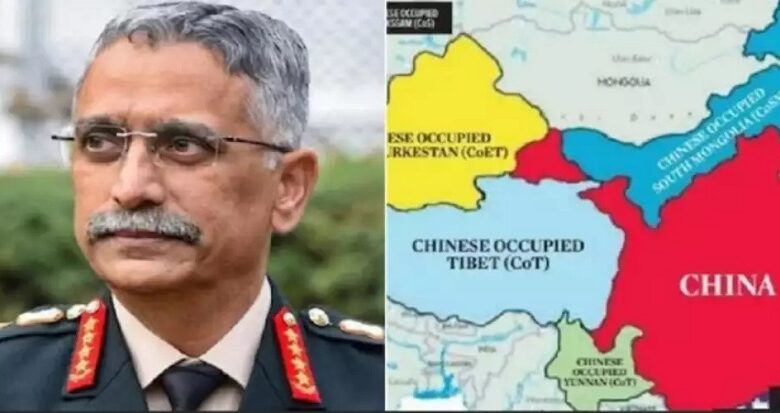
On September 12th, former Chief of Army Staff General Manoj Naravane (retd) took to X (formerly Twitter) to share a map that reignited tensions between India and China. The map, adorned with multiple colors, was accompanied by the caption, “Finally someone has got the map of China as it really is.” This seemingly innocuous act of sharing a map served as a pointed dig at China’s expansive territorial claims and triggered a fresh round of diplomatic exchanges between the two nations.
The map in question delineated several regions as ‘occupied’ areas, notably including Ladakh and Tibet. This digital provocation came on the heels of Beijing’s release of the 2023 edition of the “standard map of China,” published on August 28th. This official Chinese map controversially laid claim to territories such as Taiwan, the South China Sea, Arunachal Pradesh, and Aksai Chin as integral parts of China. India promptly rejected this so-called “standard map,” reaffirming its sovereignty over Arunachal Pradesh and Aksai Chin, and registering a strong protest with the Chinese government. New Delhi emphasized that such actions by Beijing only serve to complicate the already thorny boundary question.
China’s attempt to assert its territorial claims did not go unnoticed or unchallenged. Several ASEAN member countries, including Japan, Malaysia, Vietnam, and the Philippines, joined India in expressing their concerns about China’s expansive territorial assertions. This collective pushback from ASEAN nations has been driven by a long-standing demand for a binding code of conduct (COC) in the South China Sea, primarily due to China’s relentless efforts to assert dominance in the region.
What adds complexity to this geopolitical equation is General Manoj Naravane’s visit to Taiwan on August 8th, accompanied by former Navy Chief Karambir Singh and former Air Chief Marshal RKS Bhadauria. The trio not only visited Taiwan but also delivered talks, despite Beijing’s vehement opposition to such interactions. China views Taiwan as a breakaway region and has consistently sought to diplomatically isolate it.
During their visit, Taiwan’s President Tsai Ing-wen played a pivotal role in the Ketagalan Forum’s 2023 Indo-Pacific Security Dialogue event, organized by Taiwan’s foreign ministry. This move was seen as a clear indication of Taiwan’s growing influence and significance on the global stage.
However, Beijing wasted no time in expressing its displeasure regarding the visit by General Naravane and his counterparts. While not explicitly naming India, the Chinese foreign ministry issued a statement firmly opposing any official interactions between Taiwan and countries that maintain diplomatic relations with China. Wang Wenbin, the spokesperson for China’s foreign ministry, stressed China’s long-standing position on the issue, stating, “We hope the country concerned will abide by the one-China principle, prudently and properly handle Taiwan-related issues and refrain from having any form of military and security cooperation with Taiwan.”
General Naravane’s visit to Taiwan was especially significant due to India’s lack of formal diplomatic relations with the island nation. On the other hand, China has consistently escalated its military activities in the vicinity of Taiwan, aiming to intimidate the democratic nation, which Beijing considers a part of its territory.
This visit by Indian officials to Taiwan sparked widespread speculation regarding India’s stance on China’s aggressive posturing towards Taiwan. It underscores India’s willingness to engage with nations in the Indo-Pacific region and its growing interest in the security dynamics of the region.
The strained relationship between India and China can be traced back to the Eastern Ladakh border dispute that erupted in May 2020. Since then, Indian and Chinese troops have remained in a prolonged standoff at various friction points in Eastern Ladakh. Despite disengagement efforts in certain areas, significant tensions persist. India has consistently emphasized the importance of maintaining peace and tranquility along the Line of Actual Control (LAC) as a prerequisite for normalizing overall relations.
Notably, India adheres to the ‘One China policy’ and does not maintain formal diplomatic relations with Taiwan. Nevertheless, the visit by General Naravane and his counterparts served as a powerful diplomatic signal and contributed to the evolving dynamics in the Indo-Pacific region.
In response to India’s diplomatic protest over the publication of the 2023 “standard map” by China, the Chinese foreign ministry defended its actions, characterizing the move as a routine practice in accordance with its laws. China urged India to maintain objectivity and composure while refraining from over-interpreting the issue.
This episode serves as a stark reminder of the complex and delicate nature of diplomatic relations in a world marked by shifting geopolitical alliances and territorial disputes. General Naravane’s map tweet may appear to be a simple act, but it carries profound implications for the geopolitical landscape in the Indo-Pacific region, further highlighting the intricate dance of diplomacy in a world where national interests and territorial claims often collide.
News Mania Desk / Agnibeena Ghosh 14th September 2023






